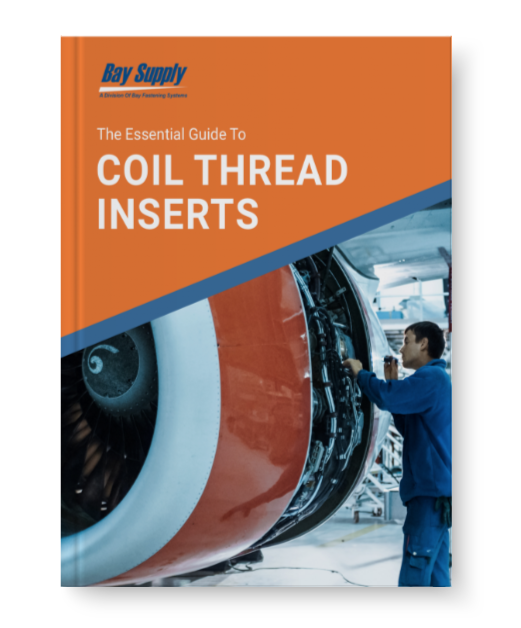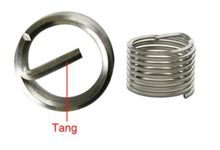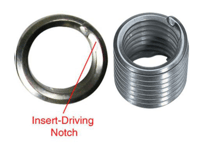What is the difference between a coil thread insert and a Heli-Coil? Actually, there is no difference. Just as Kleenex is commonly used to refer to facial tissue and Xerox has become synonymous with photocopies, “helicoil” has become a commonly recognized term for screw thread inserts. Heli-Coil® is a registered trademark of Stanley Engineered Fastening, a division of Stanley Black & Decker. Its design has become the industry standard for coil thread inserts.
Coil thread inserts, also known as helically wound inserts, are coiled wire inserts placed inside the drill hole to create a strong threaded surface to secure a bolt or other threaded fastener. When a drill hole has been stripped or the material is too soft to secure a drilled fastener, as can be the case with magnesium, wood, aluminum, zinc, or plastics, the coil provides an extremely strong and lasting bond by transferring the pressure exerted from the bolt to the sides of the parent material.
The helically wired coil is screwed into place and creates a threaded track for the screw threads of a bolt or fastener. The diameter of the coil is wider than the tapped hole, so as the bolt is screwed in, the coil compresses against the side of the tapped hole. This compression creates a safe and highly secure connection—much stronger and with more torque than similar assemblies. In fact, when used for repairs, coil thread inserts create a stronger bond than the original tapped hole.
With ordinary bolt-and-hole inserts, the top two screw threads carry 65-75 percent of the load. Helically wound inserts distribute the load so each coil shares part of the load across the length of the coil. The result is a stronger connection and longer thread life, even after assembling and disassembling multiple times.
Coil thread inserts are especially useful in applications that have to withstand stress, severe vibrations, and extreme temperatures. Even under extreme conditions, these inserts minimize wear of the threaded hole and increase the integrity and useful lifespan of the connection. That’s why coil thread inserts have become a popular fastener solution for critical applications such as automotive manufacturing, aerospace, railways, factory machinery, and transportation systems.
Coil thread inserts are quite versatile and available in a wide range of thread diameters and thread sizes. They also come in a variety of materials. Stainless steel coil thread inserts, for example, are resistant to corrosion and extend the useful life of the fastener. They also can withstand temperatures ranging from -320 degrees to +800 degrees Fahrenheit because the coils can expand and contract with temperature changes.


 CoilThread tanged inserts are extremely reliable and long-lasting. CoilThread is made from cold-rolled 304 stainless steel wire (AS7345), and work-hardened to a rating of Rc 43-50 and a tensile strength that exceeds 200,000 psi. More importantly, the finished surface is extremely smooth (8-16 microinches), which virtually eliminates thread erosion caused by friction. CoilThread is also available in other materials, such as phosphor bronze, Inconel X-750, Nitronic 60®, Nimonic 90®, and titanium, as well as stainless steel. They also come with special coatings for specific applications.
CoilThread tanged inserts are extremely reliable and long-lasting. CoilThread is made from cold-rolled 304 stainless steel wire (AS7345), and work-hardened to a rating of Rc 43-50 and a tensile strength that exceeds 200,000 psi. More importantly, the finished surface is extremely smooth (8-16 microinches), which virtually eliminates thread erosion caused by friction. CoilThread is also available in other materials, such as phosphor bronze, Inconel X-750, Nitronic 60®, Nimonic 90®, and titanium, as well as stainless steel. They also come with special coatings for specific applications. Increasingly, manufacturers are moving to tang-free coil thread inserts because they are just as easy to install and they eliminate the need to remove the tang. This removes the risk of loose tangs or pieces of metal getting into the machinery, and it speeds up installation and inspection time. Some helical coil makers estimate you can save between $0.15-$0.50 per hole by standardizing on tang-free coil thread inserts. These helically wound inserts are especially popular with electronics manufacturers and high-tech manufacturing—wherever smaller, high-precision inserts are used.
Increasingly, manufacturers are moving to tang-free coil thread inserts because they are just as easy to install and they eliminate the need to remove the tang. This removes the risk of loose tangs or pieces of metal getting into the machinery, and it speeds up installation and inspection time. Some helical coil makers estimate you can save between $0.15-$0.50 per hole by standardizing on tang-free coil thread inserts. These helically wound inserts are especially popular with electronics manufacturers and high-tech manufacturing—wherever smaller, high-precision inserts are used.
